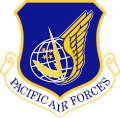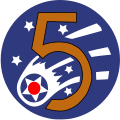This article needs additional citations for verification .(December 2012) |
80th Fighter Squadron  | |
|---|---|
 80th Fighter Squadron F-16 Fighting Falcon [note 1] | |
| Active | 1942–1945; 1947–present |
| Country | |
| Branch | |
| Role | Fighter |
| Size | 16 aircraft |
| Part of | Pacific Air Forces |
| Nickname(s) | Headhunters [1] Juvats |
| Motto(s) | Audentes Fortuna Juvat [note 2] |
| Mascot(s) | WOODY!! |
| Engagements | Southwest Pacific Theater Korean War Vietnam War [2] |
| Decorations | Distinguished Unit Citation Air Force Outstanding Unit Award Philippine Presidential Unit Citation Republic of Korea Presidential Unit Citation Republic of Vietnam Gallantry Cross with Palm [2] |
| Commanders | |
| Current commander | Lt Col Tyler "Vegas" Young |
| Insignia | |
| 80th Fighter Squadron emblem (approved 9 October 1986) [2] [note 3] |  |
| 80th Fighter Squadron emblem (World War II) |  |
The 80th Fighter Squadron (traditionally nicknamed the "Headhunters", and since 1971 also the "Juvats") is a General Dynamics F-16 Fighting Falcon fighter squadron of the United States Air Force, currently part of the 8th Operations Group of the 8th Fighter Wing, and stationed at Kunsan Air Base, Republic of Korea.
Contents
- History
- World War II
- Occupation of Japan and Korean War
- Vietnam War
- Return to Japan
- Korean service
- Lineage
- Assignments
- Stations
- Aircraft
- See also
- References
- Notes
- Bibliography
- External links
The 80th has served in combat operations in World War II, the Korean War, and the Vietnam War.





